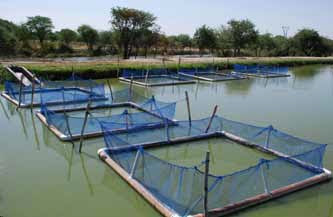 |
| ©FAO Aquaculture photo library/V. Crespi |
Aquaculture production in sub-Saharan Africa remains low with a per capita consumption of 9.1 kg/year, the FAO says.
The potential is unexploited, and countries such as the Republic of Namibia, which has one of the most productive fishing grounds in the world, also has great potential for freshwater aquaculture development due to its favorable weather conditions. However, there is a lack of high-quality fish seed and feed available, as well as limited technical capacity in the aquaculture industry. This project is finding innovative ways to produce fish in remote areas. Farmed fish can provide additional income and could guarantee a steady supply to rural communities which currently have limited access to fish as part of their diet.
DEVELOPMENT SOLUTION
The project is introducing better aquaculture management practices to enhance production per unit of aqua farms. Best practices include high-quality fish seed and feed whilst ensuring that farming systems are environmentally and economically sustainable. Results show that communities living in remote areas of Namibia are benefiting from these new aquaculture opportunities and the Government of Namibia is very supportive of the initiative, through institutional backing. The Directorate of Aquaculture and Inland Fisheries under the Ministry of Fisheries and Marine Resources (MFMR) is playing an important role in engaging the private sector in this project. This is expected to enhance product development and marketing.
SOLUTION EXCHANGE
Since 2011, FAO has been facilitating knowledge sharing through South-South Cooperation (SSC) between Namibia and Viet Nam, with Spain as a triangular partner providing USD 1.8 million in financial support. Furthermore, the Government of Namibia is providing in-kind contributions amounting to USD 0.5 million. These combined efforts have enabled eight Vietnamese experts to support aquaculture development in the country and provide on the job training to Namibian staff from the Inland Aquaculture Centres (IACs). The project is primarily focusing on strengthening the capacity of the IACs of the Directorate of Aquaculture (DOA) around the country. The aim is to enable trained staff to provide technical support to farmers wishing to engage in aquaculture alongside their current agriculture activities.
 |
| ©FAO Aquaculture photo library/V. Crespi |
To date, key results include:
1. A national genetic selection programme for Oreochromis andersonii, three spotted tilapia boost seed quality and growth performance Through the selective breeding programme and genetic improvement of three spotted tilapia, better seed quality and growth performance has been achieved for Namibia’s environmental conditions. In addition, 50 hapa for conditioning brood fish and 50 hapa for nursing fry and fingerlings were also provided by FAO.
2. Number of farmers and technicians trained. Through the SSC Programme, five subjects (fish collection, fish and shrimp acclimatization, genetic selection, tilapia sex reversal technique and development) of extension materials were conducted by four FAO consultants. In addition, 50 key technicians of DOA have participated in the training courses conducted by FAO Namibia and the Fisheries and Aquaculture Department of FAO (FIRA). These courses focused in providing the principles of the genetic selection and technical guidance for the implementation of the selective breeding programme.
3. Applying sex reversal techniques increases the production of the three spotted tilapia National aquaculture staff were able to produce 95 percent male Tilapia, which grow faster than the female. The hormonal sex reversal technique has been adopted by the main seed production centres in Namibia so that local farmers can enhance production and increase profitability.
4. Improved fish feed quality and feed management practices This study contributed the knowledge and experiences for key technicians of DOA, especially technicians from the feed plant to the improvement of feed quality and management practices. DOA staff is now playing an important role in the feed quality control and in the extension service network and consequently better feeding practices are being developed throughout the country. In addition, a new nutritional laboratory with advanced equipment was established for better quality control for the current feed production line.
 |
| ©FAO Aquaculture photo library/V. Crespi |
6. Developed training materials for capacity building Two training materials were developed by FIRA, FAO and SSC team and are being used as good technical guidance for trainers (DOA staff) and fish farmers. The technical documents are being used in the aquaculture extension networks over the country.
7. Low-input techniques improves fish production at farm level Several small-scale community-based aquaculture projects have been established and supported, aiming at promoting aquaculture practices.
POTENTIAL FOR UPSCALING
The results described hold significant potential for upscaling. With continued investment, public institutions and the private sector alike, have even greater potential to guide the sustainable development and growth of the freshwater aquaculture sector in the country. This project has served to enhance sustainable livelihoods, help eliminate poverty and create jobs, all of which are key to the Government of Namibia’s strategic planning goals.
Visit the FAO aquaculture page HERE.
The Aquaculturists
This blog is maintained by The Aquaculturists staff and is supported by the
magazine International Aquafeed which is published by Perendale Publishers Ltd
For additional daily news from aquaculture around the world: aquaculture-news

No comments:
Post a Comment